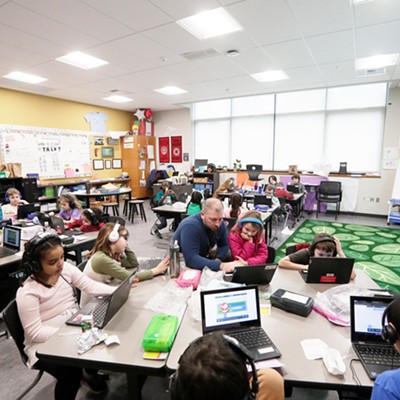Lately, no matter how hard teachers fight, Spokane Public Schools can’t seem to nudge its dropout rate below 28 percent. But Communities in Schools Director Ben Stuckart and other educational advocates think they can change that. They have a goal: Pass a levy, collect $5 million a year and, in six years, slash the dropout rate by as much 20 percent. The big question, naturally, is whether that would work.
This November, voters will likely have a chance to vote to raise Spokane’s city property taxes by 35 cents for every $1,000 of assessed value (about $69 annually for the average house) to fund something called the Children’s Investment Fund.
In a way, the Children’s Investment Fund would be a grant foundation funded by the taxpayers. Four types of local programs could apply for funding from the $5 million pool the levy would create: abuse and neglect services, early childhood learning, mentoring and after-school programs.
An 11-member Citizens Oversight Committee (including representatives from Spokane Public Schools, the City Council, the juvenile justice system, the business community and high-dropout neighborhoods) would decide which other organizations receive that money. Administration of the fund would cost a max of $250,000 — the rest would go to directly fund programs.
But with brand-new taxes a tough sell in a rough economy, some are skeptical.
“Certainly all of us are very much concerned about the dropout rate here and everywhere,” former County Commissioner Kate McCaslin says.
“I just happen to think that many people share this view: Throwing more money at that problem is not going to resolve it.”
THE BENEFICIARIES
Stuckart certainly wouldn’t characterize it as “throwing money.” In fact, only programs with an extensively documented, proven track record of success can apply for funding.
That includes organizations like Partners with Families and Children, a child-abuse treatment agency, and Big Brothers Big Sisters, which pairs at-risk children (like children below the poverty line or without a stable family situation) with older mentors.
You want solid evidence of success? Big Brothers CEO Darin Christensen rattles off the stats: An at-risk child with mentorship is 37 percent less likely to skip a day of class, 46 percent less likely to be involved with drugs or alcohol, and, yes, 52 percent less likely to drop out of school.
“We know — this is proven by research — if we can introduce a caring adult into a child’s life, we can create an outcome that will significantly [improve],” he says. Introduce enough mentors, Christensen says, and see the dropout rate plummet.
But it costs $1,000 to pair a mentor with a child. Used to be, they’d be able to serve 800 kids. But the same old nonprofit recession story — donations down, and investments down even further — reduced that to 400.
Say the Children’s Investment Fund gives $50,000 to Big Brothers Big Sisters (the minimum amount the fund is allowed to give to an organization). That’s 50 more mentors for 50 more kids.
And crucially, unlike many foundation donations, the Children’s Investment Fund dollars won’t disappear after a few years.
THE CASE STUDIES
We don’t have to speculate idly. The Children’s Investment Fund’s idea has precedent.
Portland created the $12.5 million Portland Children’s Levy in 2002, and Seattle passed the Family and Education Levy in 1990, while Miami developed the $116 million Children’s Trust in 2002. And in each city, the levy was renewed by their voters in a landslide. Portland, Miami and Seattle voters, at least, called their programs effective.
The Portland program serves 1,600 kids and funds more than 70 programs, says Mary Gay Broderick, communications director for the Portland Children’s Levy. One program, Step Up, helps 300 students each year with the transition between middle school and high school.
“When you have a solid level of funding, it allows you to grow your programs,” Step Up’s Hanif Fazal says.
But here’s the thing: So far, the dropout rates in Miami, Seattle,
and Portland have not had clear reductions. In fact, while the dropout rate for Oregon has been steadily ticking downward, in the last two years, the Portland School District returned to previous levels.
Much of the proof of Portland’s success has been anecdotal, Broderick says: This saved my family. I was able to find day care. Now my child is doing well.
David Lawrence, former Miami Herald publisher, the founding chair of the Children’s Trust, brags about the Miami program’s success. But with such a maelstrom of factors determining dropout rates — nutrition, family life, school standards, educational style and techniques, psychology, class size — he says it’s ridiculous to expect a mere few years’ investment to make a large difference.
“It’d be ludicrous to think that in two, three, four, five years [the dropout rate would be affected],” Lawrence says. “Nobody that I know of in the United States of America could do that.”
Stuckart, however, notes that none of the other programs started with reducing dropout rates as a specific goal. The Spokane program would. He lists several studies showing mentorship and early childhood intervention successfully reducing dropout rates.
Some programs show success — like the Early Head Start program to which the Portland Children’s Levy gave $4.3 million in 2003 — but other studies find those gains erased by an awful educational environment later.
That, says Christensen of Big Brothers, is why a continuum of programs is necessary — high-risk children need support through infancy, preschool, grade school, middle school, high school and graduation.
Of course, if the dropout rate changes in the next few years, it may not be because of the Children’s Investment Fund. Currently, district spokeswoman Terren Roloff says, Spokane Public School’s number is artificially high. Those numbers include students whose status is unknown — in many cases, “dropouts” may just be a student who transferred without the district recording that fact. Since the district has hired an employee to determine the status of students who’ve left, the rate may be reduced anyway.
Here’s one thing that Stuckart the levy advocate, McCaslin the skeptic, and Lawrence from Miami all said, independently: When it comes to dropout rates, there’s no silver
























